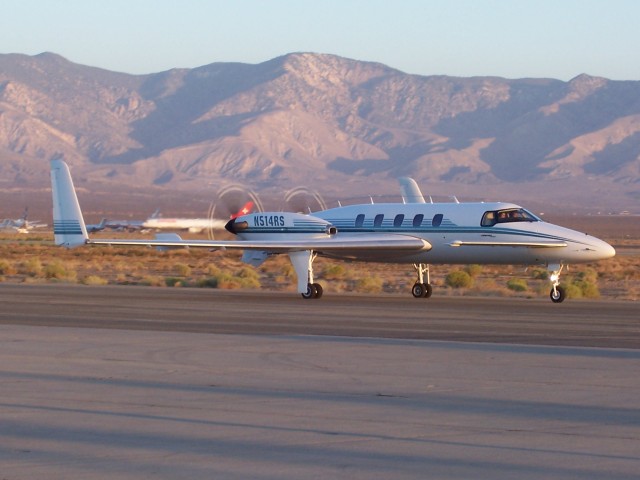
Beechcraft Starship N514RS at Mojave, CA
I think it is quite obvious that I grew up loving aviation. As a child, when the Beechcraft Starship first was developed, I was instantly in love. Over 25 years later, it is still one modern and beautiful looking aircraft. The story of the Starship is sad and ends with only five still flying around the world.
Back in April 2010, after watching every video of the Starship I could find and being motivated by the one hanging from the Future of Flight, I put myself to the challenge of trying to get a ride in one.
I have had a lot of great (and sometimes crazy) flying experiences, but this is the one I have been pining over for a long time. I was very lucky to find Robert Scherer who owns NC514RS. He also holds most of the remaining Starship parts to make sure the the ones left remain flying for a long time.
I had the honor of meeting Robert and his airplane while at Oshkosh 2010. We were all set to fly from Aspen to Orange, CA in January of this year, but it did not work out. I took my flight from Seattle to Denver and was waiting for my connect to Aspen, but the weather had different plans and my flight was cancelled. Luckily I was able to hitch a ride back to Seattle, but my dream of flying of the Starship would have to wait.
So, it is time once again to give this a try. I have my tickets and we are all set to fly from Aspen to Orange, CA on Robert’s Starship on Sunday. Of course, I will be documenting every step of the way via photos, video and social media. The weather looks great and I gave myself plenty of time to get there, so let’s hope this time will work out.
My Quest to Ride on a Beechcraft Starship:
IDEA | CONNECT | TOUR | FLIGHT-PLAN | FAIL | FLIGHT | PHOTOS | VIDEO
Image: Kirk Kittell
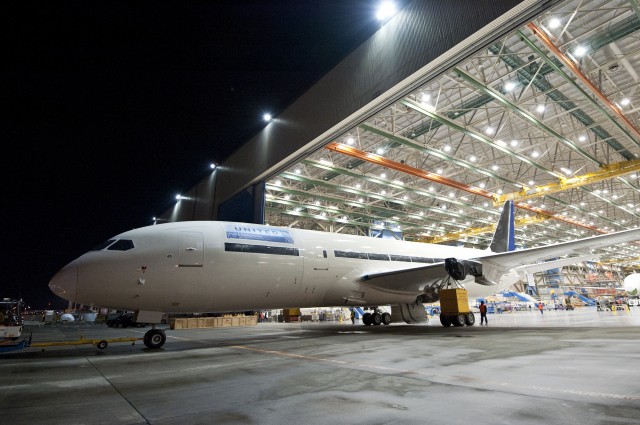
United's first Boeing 787 Dreamliner is pulled out of the factory. Image from Boeing. Click for Larger.
Wednesday night, Boeing pulled out United Airline’s first 787 Dreamliner from the factory and off the final assembly line. The first 787 Dreamliner has already been delivered to the launch customer, ANA, but United will be the first North American airline to take delivery of the new aircraft. From United’s press release: “While in final assembly, the aircraft moved through four factory positions, including the final aircraft body join, landing gear installation, weight-on-wheels testing and installation of interior components and systems. Over the next several months, the aircraft will move to the next phase of completion, which includes final cabin configuration, installation of engines and painting.”
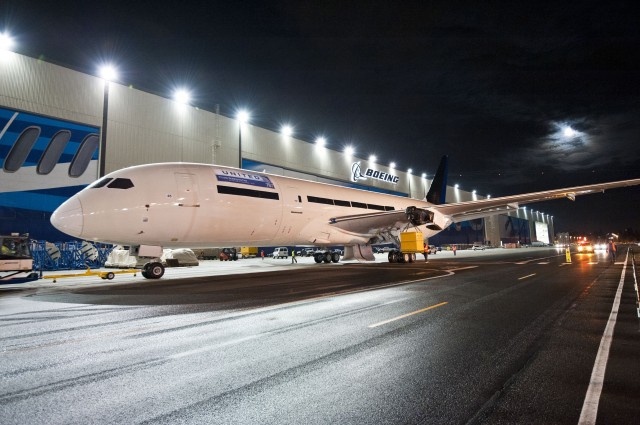
United's first Boeing 787 Dreamliner gets pulled in front of the factory located in Everett, WA. Photo by Boeing. Click for larger.
United will configure their first 787 with 36 seats in BusinessFirst, 63 seats in Economy Plus and 120 seats in Economy. There was some speculation if United might be offering a special livery, but I doubt it. When I was on the factory floor recently, the tail was definitely a solid blue, which matches United’s current “new” livery. With United recently switching their brand over from the tulip to the globe, it wouldn’t really make sense for them to also introduce a special livery. Normally I am all for any livery that spices things up, but at this stage it would just cause brand confusion.
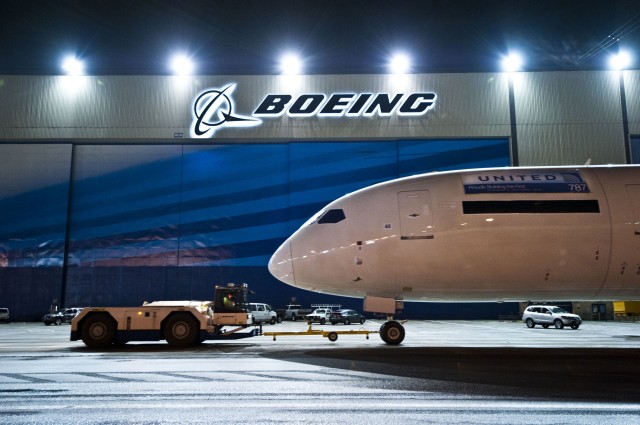
Nose show of United Airline's first Boeing 787 Dreamliner outside the factory at Paine Field. Photo by Boeing. Click for larger.
Although the exact date of delivery is unknown, United told AirlineReporter.com that they expect to get their first 787 during the, “second half of 2012.” It will be the first of 50 that the airline has on order.
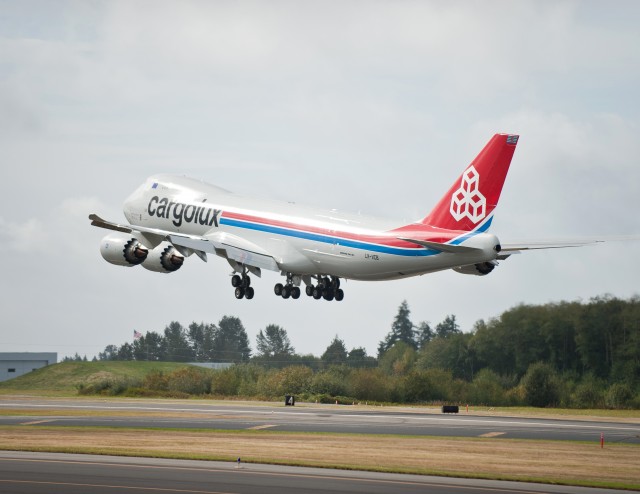
Cargolux's first Boeing 747-8F (LX-VCB) takes off from Paine Field earlier today. Photo by Boeing. Click for hi-res.
No music, no balloons and no Champagne to celebrate Boeing’s first delivery of their new 747-8F (LX-VCB) yesterday. It is really sort of sad that so much has gone into making the new 747-8F and it took off from Paine Field with almost no fanfare.
The plane was supposed to be delivered with three days of celebration on September 19th. Cargolux was not happy with the 747’s performance and went into negotiations with GE and Boeing. All three companies were silent during these negotiations and it wasn’t until September 30th, that Cargolux/Qatar Airways announced it was looking to take delivery on October 12th. Many were waiting to see what would happen after an October 7th board meeting, but all three still remained mostly silent.
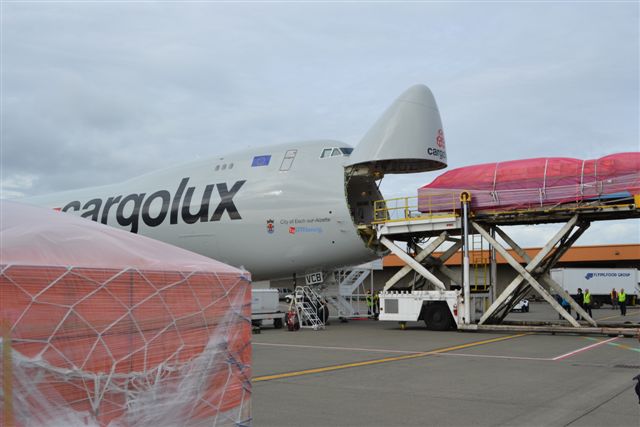
The Boeing 747-8F gets its first real cargo load at SEA. Photo by the Port of Seattle.
It was not until early yesterday morning that rumors started to turn into facts when it became clear that Cargolux would take delivery of their first 747-8F. Even though it should have been a happy day, it just feels like it was sort of stolen. Yes, it is great that in the last 30-days, Boeing has finally delivered not only their first 747-8F, but also their first 787 Dreamliner, but it is just unfortunate that all the employees who have spent many hours on the aircraft were not able to celebrate like the 787 team did.
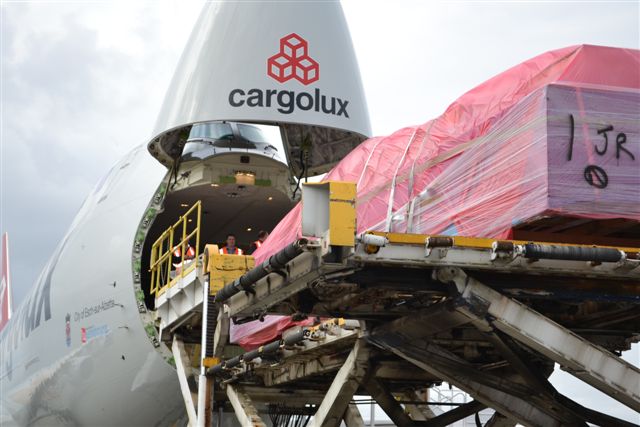
Nose up. Cargo in. It didn't take long for Cargolux to put their new 747-8F to work. Photo from the Port of Seattle.
After being handed over to Cargolux, LX-VCB’s first flight was short. A quick hop from Paine Field (PAE), down to Seattle-Tacoma International Airport (SEA) where it took a few hours to be loaded with cargo and then off to Luxembourg. Although seeing a Cargolux Boeing 747 at SEA is nothing new.
Cargolux is one SEA’s longest serving cargo carriers which began in 1983 and in 2010, the airline shipped 8,796 metric tons of cargo through SEA. “We appreciate the commitment by Cargolux to this region’s freight hauling capacity by placing this historic aircraft into service right here at Sea-Tac,” said Mark Reis, Managing Director of Sea-Tac Airport. “This investment by our freight partner highlights the capabilities of Sea-Tac’s air cargo service as an economic engine to our entire region.”
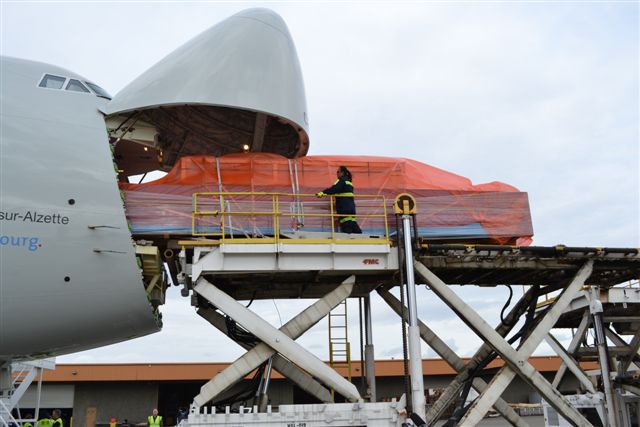
Easy does it. Surely don't want to damage a brand new plane. Photo from the Port of Seattle.
It is interesting that on Boeing’s press release for the delivery, they don’t give exact numbers on the 747-8’s increased performance vs the 747-400. ’œThe 747-8 Freighter offers double-digit improvements in fuel burn, operating cost and lower emissions over the airplane it replaces.’ Previously Boeing has stated a 16% performance gain, which Carglux has stated there is a 2.7% shortfall in that gain, which has caused the delivery delay.
Here are some other Cargolux Delivery goodies to check out:
* Seattle PI photos of the delivery
* Video from the Future of Flight
* Boeing’s official Boeing 747-8F first delivery website

Cargolux Boeing 747-8F. It appears the first delivery will happen today.
From multiple sources, it looks like the first Boeing 747-8F is finally set to be delivered to Cargolux sometime today after a lot of complications. As of now the aircraft shows to be leaving Paine Field at 11am and heading to Seattle-Tacoma International Airport (SEA) on Flight Aware.
Boeing is not confirming the delivery and told me that it would be announced when the delivery takes place (which could be before or after).
Jon Ostrower is also hearing that the first 747-8F will deliver to Cargolux today. It appears that instead of the three-day celebration of the delivery, the delivery will be done quietly. Let’s hope there will be a celebration of Cargolux’s second delivery.
Update:
Boeing has confirmed that Cargolux will receive their first Boeing 747-8F today at Paine Field. The plane will depart from Paine Field at about 11am and is scheduled to have a short, six minute flight to SEA, to presumably load up with Cargo before heading home to Luxembourg.
The second 747-8F is scheduled to be delivered to Cargolux tomorrow, October 13th.
WATCH THE CARGOLUX 747-8F TAKE OFF VIA PAINE FIELD’S WEBCAM (thanks Mark)
Image: flypdx
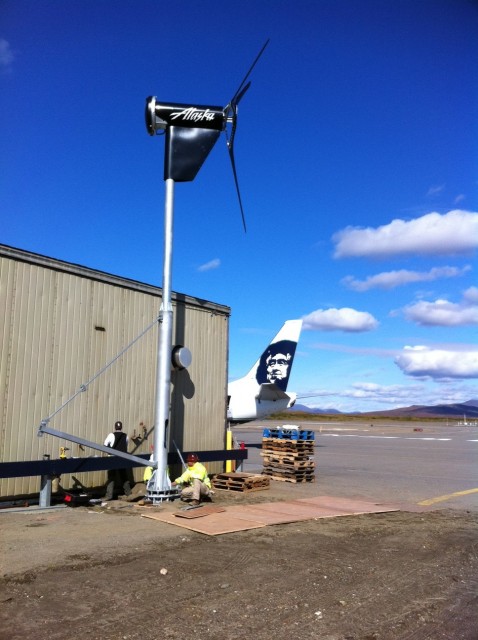
Wind power for Alaska Airlines up in Nome, Alaska. Photo from Alaska Airlines.
So where the heck is Nome, Alaska? It is pretty darn as close to the middle of no where as you can get, although it is on the western edge of Alaska. It is a small town of less than 4,000 people and transportation to destinations outside the city is difficult to come by. Roads connect Nome to smaller cities up to 54 miles away, but there are no roads connecting the city to the rest of the world. For the town to operate, it requires transportation via water and air.
Air travel becomes a necessity to get goods and people to and from remote areas in Alaska and Alaska Airlines is one of a few airlines operating out of Nome ’“ it is also the largest.
Nome has long days in the summer, short in the winter and is the end destination of the Iditarod dog sled race. The remote city is also known for its fierce winds of 80 to 90mph. With being so remote, having strong winds and long days of light in the summer, it makes sense for locals to look at alternative sources of energy and that is just what Alaska Airlines has done.
Recently the airline built a 30-foot wind turbine next to the Nome Terminal and installed solar panel array on the roof. According to Alaska, ’œthe project is the first foray for Alaska Airlines into using wind and solar power to produce a significant amount of an airport’s electricity ’“ and it appears to be the first time a domestic carrier has pursued alternative energy for an airport operation.’
Alaska is hoping that the turbine and solar panels will produce around 15,000 kilowatt hours of power per year, which is about 6 percent of the terminal’s load. If successful, the concept may be expanded to other rural airports in Alaska, said Ron Suttell, Alaska’s director of facilities planning and administration.
“The turbine was selected because it performs well in turbulent air, it is engineered to continue producing electricity in harsh climates and high winds, and the design eliminates icing issues on the blades,” Chris Andree, Alaska Airlines’ regional manager of properties and facilities, who oversaw the project for the airline.









